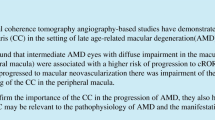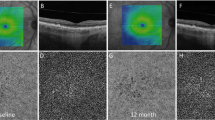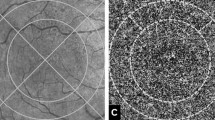Abstract
Purpose
To evaluate the choriocapillaris flow in regions of enlarged or new incident drusen in patients with early and intermediate age-related macular degeneration (AMD).
Methods
We retrospectively reviewed and analyzed structural optical coherence tomography (OCT) and OCT angiography (OCTA) images of consecutive patients with early or intermediate AMD evaluated at the Doheny-UCLA Eye Centers between 2015 and 2018. All patients were imaged using a Cirrus OCT, and only one eye was included in the study. To be eligible for this analysis, patients were required to have a 3 × 3-mm OCTA scan acquired during the first visit (considered as baseline) and a fovea-centered 512 × 128 macular cube (6 × 6 mm) acquired at both the baseline visit and after a minimum of 1 year follow-up. The drusen maps generated from the macular cubes were used to generate a drusen area (DA) measurement and compute the difference between baseline and follow-up (ΔDA). After registering the structural OCTs to the baseline choriocapillaris (CC) OCTA, we analyzed and compared the baseline flow deficits (FD) within drusen-free region (FDDF), regions into which drusen enlarged or expanded at follow-up (FDEN), and regions in which new incident drusen (FDND) appeared at follow-up.
Results
Forty-six patients were eligible for the analysis and had a mean follow-up of 1.47 years. Twelve eyes of 12 subjects had a ΔDA < 0.1 mm2. In these eyes, only the FDDF was calculated (40.37 ± 2.29%) and it was not significantly different from the FDDF of eyes with ΔDA ≥ 0.1 mm2 (40.25 ± 4.37%, p = 0.849). When comparing the different regions within the eyes with ΔDA ≥ 0.1 mm2, there was no significant difference between FDED and FDND (43.61 ± 4.36% and 44.16 ± 2.38%, p = 528), but both were significantly higher than FDDF (p = 0.001 and p < 0.001, respectively).
Conclusions
Significant CC flow impairment is present under regions of intact retinal pigment epithelium (RPE) where existing drusen will enlarge into or new drusen will appear within 2 years. These findings suggest that location of drusen may not be stochastic but may be driven by regional deficits in the choriocapillaris.




Similar content being viewed by others
References
Bird AC, Bressler NM, Bressler SB et al (1995) An international classification and grading system for age-related maculopathy and age-related macular degeneration. The International ARM Epidemiological Study Group. Surv Ophthalmol 39:367–374
Saksens NTM, Geerlings MJ, Bakker B et al (2016) Rare genetic variants associated with development of age-related macular degeneration. JAMA Ophthalmol 134:287–293. https://doi.org/10.1001/jamaophthalmol.2015.5592
Klein R, Myers CE, Cruickshanks KJ et al (2014) Markers of inflammation, oxidative stress, and endothelial dysfunction and the 20-year cumulative incidence of early age-related macular degeneration: the Beaver Dam Eye Study. JAMA Ophthalmol 132:446–455. https://doi.org/10.1001/jamaophthalmol.2013.7671
Querques G, Rosenfeld PJ, Cavallero E et al (2014) Treatment of dry age-related macular degeneration. Ophthalmic Res 52:107–115. https://doi.org/10.1159/000363187
Zarbin MA, Rosenfeld PJ (2010) Pathway-based therapies for age-related macular degeneration: an integrated survey of emerging treatment alternatives. Retina Phila Pa 30:1350–1367. https://doi.org/10.1097/IAE.0b013e3181f57e30
Spaide RF (2016) Choriocapillaris flow features follow a power law distribution: implications for characterization and mechanisms of disease progression. Am J Ophthalmol 170:58–67. https://doi.org/10.1016/j.ajo.2016.07.023
Al-Sheikh M, Falavarjani KG, Pfau M et al (2017) Quantitative features of the choriocapillaris in healthy individuals using swept-source optical coherence tomography angiography. Ophthalmic Surg Lasers Imaging Retina 48:623–631. https://doi.org/10.3928/23258160-20170802-04
Borrelli E, Sarraf D, Freund KB, Sadda SR (2018) OCT angiography and evaluation of the choroid and choroidal vascular disorders. Prog Retin Eye Res 67:30–55. https://doi.org/10.1016/j.preteyeres.2018.07.002
Nassisi M, Baghdasaryan E, Tepelus T et al (2018) Topographic distribution of choriocapillaris flow deficits in healthy eyes. PLoS One 13:e0207638. https://doi.org/10.1371/journal.pone.0207638
Forte R, Haulani H, Jürgens I (2018) Quantitative and qualitative analysis of the three capillary plexuses and choriocapillaris in patients with type 1 and type 2 diabetes mellitus without clinical signs of diabetic retinopathy: a prospective pilot study. Retina Phila PA. https://doi.org/10.1097/IAE.0000000000002376
Borrelli E, Souied EH, Freund KB et al (2018) Reduced choriocapillaris flow in eyes with type 3 neovascularization and age-related macular degeneration. Retina Phila PA. https://doi.org/10.1097/IAE.0000000000002198
Nassisi M, Lavia C, Alovisi C et al (2017) Short-term choriocapillaris changes in patients with central serous chorioretinopathy after half-dose photodynamic therapy. Int J Mol Sci 18(11):E2468. https://doi.org/10.3390/ijms18112468
Nassisi M, Shi Y, Fan W, et al (2018) Choriocapillaris impairment around the atrophic lesions in patients with geographic atrophy: a swept-source optical coherence tomography angiography study. Br J Ophthalmol https://doi.org/10.1136/bjophthalmol-2018-312643
Uji A, Balasubramanian S, Lei J et al (2017) Impact of multiple en face image averaging on quantitative assessment from optical coherence tomography angiography images. Ophthalmology. 124(7):944–952. https://doi.org/10.1016/j.ophtha.2017.02.006
Borrelli E, Uji A, Sarraf D, Sadda SR (2017) Alterations in the choriocapillaris in intermediate age-related macular degeneration. Invest Ophthalmol Vis Sci 58:4792–4798. https://doi.org/10.1167/iovs.17-22360
Nittala MG, Ruiz-Garcia H, Sadda SR (2012) Accuracy and reproducibility of automated drusen segmentation in eyes with non-neovascular age-related macular degeneration. Invest Ophthalmol Vis Sci 53:8319–8324. https://doi.org/10.1167/iovs.12-10582
Schneider CA, Rasband WS, Eliceiri KW (2012) NIH image to ImageJ: 25 years of image analysis. Nat Methods 9:671–675
Bearelly S, Chau FY, Koreishi A et al (2009) Spectral domain optical coherence tomography imaging of geographic atrophy margins. Ophthalmology 116:1762–1769. https://doi.org/10.1016/j.ophtha.2009.04.015
Uji A, Balasubramanian S, Lei J et al (2017) Choriocapillaris imaging using multiple en face optical coherence tomography angiography image averaging. JAMA Ophthalmol 135(11):1197–1204. https://doi.org/10.1001/jamaophthalmol.2017.3904
Spaide RF (2017) Choriocapillaris signal voids in maternally inherited diabetes and deafness and in pseudoxanthoma elasticum. Retina 37(11):2008–2014. https://doi.org/10.1097/IAE.0000000000001497
Curcio CA, Messinger JD, Sloan KR et al (2013) Subretinal drusenoid deposits in non-neovascular age-related macular degeneration: morphology, prevalence, topography, and biogenesis model. Retina Phila Pa 33:265–276. https://doi.org/10.1097/IAE.0b013e31827e25e0
Mullins RF, Johnson MN, Faidley EA et al (2011) Choriocapillaris vascular dropout related to density of drusen in human eyes with early age-related macular degeneration. Invest Ophthalmol Vis Sci 52:1606–1612. https://doi.org/10.1167/iovs.10-6476
Ramrattan RS, van der Schaft TL, Mooy CM et al (1994) Morphometric analysis of Bruch’s membrane, the choriocapillaris, and the choroid in aging. Invest Ophthalmol Vis Sci 35:2857–2864
Friedman E, Smith TR, Kuwabara T (1963) Senile choroidal vascular patterns and drusen. Arch Ophthalmol Chic Ill 1960 69:220–230
Sarks SH, Arnold JJ, Killingsworth MC, Sarks JP (1999) Early drusen formation in the normal and aging eye and their relation to age related maculopathy: a clinicopathological study. Br J Ophthalmol 83:358–368
Lengyel I, Tufail A, Hosaini HA et al (2004) Association of drusen deposition with choroidal intercapillary pillars in the aging human eye. Invest Ophthalmol Vis Sci 45:2886–2892. https://doi.org/10.1167/iovs.03-1083
Seddon JM, McLeod DS, Bhutto IA et al (2016) Histopathological insights into choroidal vascular loss in clinically documented cases of age-related macular degeneration. JAMA Ophthalmol 134:1272–1280. https://doi.org/10.1001/jamaophthalmol.2016.3519
Korte GE, Reppucci V, Henkind P (1984) RPE destruction causes choriocapillary atrophy. Invest Ophthalmol Vis Sci 25:1135–1145
Bhutto I, Lutty G (2012) Understanding age-related macular degeneration (AMD): relationships between the photoreceptor/retinal pigment epithelium/Bruch’s membrane/choriocapillaris complex. Mol Asp Med 33:295–317. https://doi.org/10.1016/j.mam.2012.04.005
Biesemeier A, Taubitz T, Julien S et al (2014) Choriocapillaris breakdown precedes retinal degeneration in age-related macular degeneration. Neurobiol Aging 35:2562–2573. https://doi.org/10.1016/j.neurobiolaging.2014.05.003
Schlingemann RO (2004) Role of growth factors and the wound healing response in age-related macular degeneration. Graefes Arch Clin Exp Ophthalmol Albrecht Von Graefes Arch Klin Exp Ophthalmol 242:91–101. https://doi.org/10.1007/s00417-003-0828-0
Cabrera AP, Bhaskaran A, Xu J et al (2016) Senescence increases choroidal endothelial stiffness and susceptibility to complement injury: implications for choriocapillaris loss in AMD. Invest Ophthalmol Vis Sci 57:5910–5918. https://doi.org/10.1167/iovs.16-19727
McLeod DS, Grebe R, Bhutto I et al (2009) Relationship between RPE and choriocapillaris in age-related macular degeneration. Invest Ophthalmol Vis Sci 50:4982–4991. https://doi.org/10.1167/iovs.09-3639
Sacconi R, Corbelli E, Carnevali A et al (2017) Optical coherence tomography angiography in geographic atrophy. Retina 38(12):2350–2355. Phila Pa. https://doi.org/10.1097/IAE.0000000000001873
Moult EM, Waheed NK, Novais EA et al (2016) Swept-source optical coherence tomography angiography reveals choriocapillaris alterations in eyes with nascent geographic atrophy and drusen-associated geographic atrophy. Retina Phila Pa 36(Suppl 1):S2–S11. https://doi.org/10.1097/IAE.0000000000001287
Cicinelli MV, Rabiolo A, Marchese A et al (2017) Choroid morphometric analysis in non-neovascular age-related macular degeneration by means of optical coherence tomography angiography. Br J Ophthalmol 101:1193–1200. https://doi.org/10.1136/bjophthalmol-2016-309481
Borrelli E, Shi Y, Uji A et al (2018) Topographical analysis of the choriocapillaris in intermediate age-related macular degeneration. Am J Ophthalmol 196:34–43. https://doi.org/10.1016/j.ajo.2018.08.014
Arya M, Sabrosa AS, Duker JS, Waheed NK (2018) Choriocapillaris changes in dry age-related macular degeneration and geographic atrophy: a review. Eye Vis 5:22. https://doi.org/10.1186/s40662-018-0118-x
Sauer L, Klemm M, Peters S et al (2017) Monitoring foveal sparing in geographic atrophy with fluorescence lifetime imaging ophthalmoscopy—a novel approach. Acta Ophthalmol 96(3):257–266. https://doi.org/10.1111/aos.13587
Dysli C, Wolf S, Berezin MY et al (2017) Fluorescence lifetime imaging ophthalmoscopy. Prog Retin Eye Res 60:120–143. https://doi.org/10.1016/j.preteyeres.2017.06.005
Burke TR, Duncker T, Woods RL et al (2014) Quantitative fundus autofluorescence in recessive Stargardt disease. Invest Ophthalmol Vis Sci 55:2841–2852. https://doi.org/10.1167/iovs.13-13624
Armenti ST, Greenberg JP, Smith RT (2016) Quantitative fundus autofluorescence for the evaluation of retinal diseases. J Vis Exp JoVE. https://doi.org/10.3791/53577
Eandi CM, Nassisi M, Lavia C et al (2017) Macular pigment density and quantitative fundus autofluorescence in young healthy subjects. Invest Ophthalmol Vis Sci 58:2284–2290. https://doi.org/10.1167/iovs.16-20510
Querques G, Kamami-Levy C, Georges A et al (2014) Appearance of regressing drusen on adaptive optics in age-related macular degeneration. Ophthalmology 121:611–612. https://doi.org/10.1016/j.ophtha.2013.10.006
Gocho K, Sarda V, Falah S et al (2013) Adaptive optics imaging of geographic atrophy. Invest Ophthalmol Vis Sci 54:3673–3680. https://doi.org/10.1167/iovs.12-10672
Abdelfattah NS, Zhang H, Boyer DS et al (2016) Drusen volume as a predictor of disease progression in patients with late age-related macular degeneration in the fellow eye. Invest Ophthalmol Vis Sci 57:1839–1846. https://doi.org/10.1167/iovs.15-18572
Nassisi M, Fan W, Shi Y et al (2018) Quantity of intraretinal hyperreflective foci in patients with intermediate age-related macular degeneration correlates with 1-year progression. Invest Ophthalmol Vis Sci 59:3431–3439. https://doi.org/10.1167/iovs.18-24143
Lei J, Balasubramanian S, Abdelfattah NS et al (2017) Proposal of a simple optical coherence tomography-based scoring system for progression of age-related macular degeneration. Graefes Arch Clin Exp Ophthalmol Albrecht Von Graefes Arch Klin Exp Ophthalmol 255:1551–1558. https://doi.org/10.1007/s00417-017-3693-y
Ouyang Y, Heussen FM, Hariri A et al (2013) Optical coherence tomography-based observation of the natural history of drusenoid lesion in eyes with dry age-related macular degeneration. Ophthalmology 120:2656–2665. https://doi.org/10.1016/j.ophtha.2013.05.029
Spaide RF, Ooto S, Curcio CA (2018) Subretinal drusenoid deposits AKA pseudodrusen. Surv Ophthalmol 63:782–815. https://doi.org/10.1016/j.survophthal.2018.05.005
Author information
Authors and Affiliations
Corresponding author
Ethics declarations
Conflict of interest
M. Nassisi, T. Tepelus, and MG Nittala declare no conflict of interest. S.R. Sadda: Allergan (Consultant, Financial Support), Carl Zeiss Meditec (Financial Support), Genentech (Consultant, Financial Support), Amgen (Consultant), Novartis (Consultant), Optos (Consultant, Financial Support), Centervue (Consultant), Heidelberg (Consultant), Regeneron (Financial Support), and Oxurion (Consultant).
Ethical approval
Data collection was approved by the institutional review board (IRB) of the University of California-Los Angeles (UCLA). The study was performed in accordance with the Health Insurance Portability and Accountability Act and adhered the principles of the 1964 Declaration of Helsinki and its later amendments.
Additional information
Publisher’s note
Springer Nature remains neutral with regard to jurisdictional claims in published maps and institutional affiliations.
Rights and permissions
About this article
Cite this article
Nassisi, M., Tepelus, T., Nittala, M.G. et al. Choriocapillaris flow impairment predicts the development and enlargement of drusen. Graefes Arch Clin Exp Ophthalmol 257, 2079–2085 (2019). https://doi.org/10.1007/s00417-019-04403-1
Received:
Revised:
Accepted:
Published:
Issue Date:
DOI: https://doi.org/10.1007/s00417-019-04403-1




